City Wall
- Perimeter: 13.74 kilometers
- Height: 12 meters
- Top Width: 12 – 14 meters
- Base Width: 15 - 18 meters
- Area: 11.32 square kilometers
- History: over 600 years
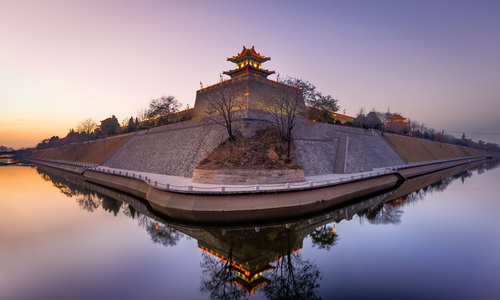
As the most eye-catching landmark of Xian, the ancient City Wall is a rectangular defensive system enclosing the city center with a perimeter of 13.74 kilometers in total. First built in 1374 of Ming Dynasty (1368-1644), Xian City Wall is blessed with an honorable history of over 600 years. As the longest and best-preserved ancient city wall in China, it has been one of the top attractions of Xi'an. The wall divides the city into the internal walled town and the external part, with 18 gates for visitors to go in and out of the town. Meanwhile, the 12-metre-high City Wall gets brick-paved walkway on the top where visitors can walk or cycle around to capture the cityscape of Xian.
- Predecessor
- Why Build the City Wall?
- Restoration and Maintenance
The predecessor of the City Wall was the wall of the imperial palace, built in 583 by order of Emperor Wen of the Sui Dynasty (581-618 AD), and inherited during the Tang dynasty (618 - 907). It was made from soil, rice fibrin and burnt lime, firmly rammed together.
In order to realize the ambition to unify the empire, Zhu Yuanzhang (the first emperor of the Ming dynasty established in 1368) followed the strategy of Zhu Sheng, a hermit, to build high walls to strengthen the base areas develop economy and wait the perfect time to unify the country. After founding his empire, Zhu ordered the whole nation to fortify the cities and completed the main structure of the City Wall in five years.
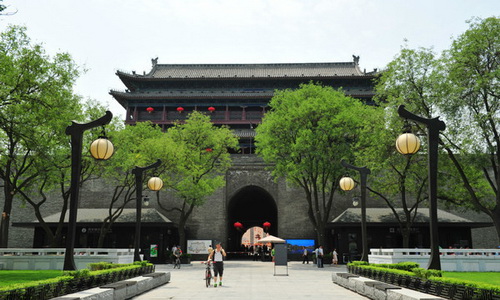
In 1568, the City Wall was further enhanced by paving blue bricks on it. During the Qing Dynasty (1636-1912), the City Wall was repaired and reinforced; crenels and a drainage system were added; and the moat was dredged for countless times, because Xi'an was a strategic stronghold vital to the security of northwestern areas. After 1911, the City Wall survived from cultural campaigns during which many other similar walls (like Beijing and Hangzhou city walls) were destroyed or demolished. In 1983, the City Wall was repaired thoroughly with a principle that the original state mustn't be changed. In modern times, the City Wall, as a symbol of Xi'an, has been maintained from time to time, and a park is built around the wall for people to relax.
The Xi'an City Wall is a series of integrated fortifications built in ancient Chinese architectural style. It appears as a rectangular brick wall, which has a walkway on top, a pinion wall with 5,984 crenels, a parapet wall, 98 abutment walls, 4 corner towers, 18 gates and many drawbridges, sluice towers, archery watchtowers, defense towers, barbican entrance to the city, etc.
Main Gates of the City Wall
There are 18 gates in total built successively as the entrances in different times and styles. The 4 original main gates are situated directly towards the four directions, namely Yongning Gate (South Gate), Anyuan Gate (North Gate), Changle Gate (East Gate) and Anding Gate (West Gate). Each consists of a watchtower and an archery tower.
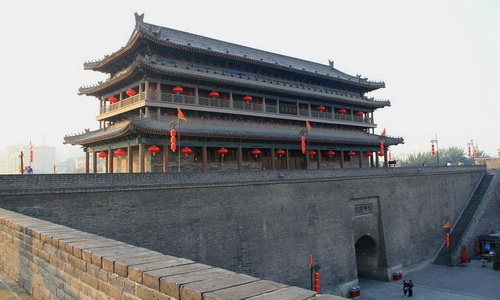
Among the four, the South Gate is the most majestic one with elegant and quaint towers. Later, more gates were opened near the four main gates for easier access of entry and exit, and most of them are still in service nowadays.
Five Defensive Lines of the City Wall
As the most intact and solid defensive system of Xian, the City Wall sets five defensive lines to guard the core area of the ancient capital. With an average width of 18 meters and depth of 6 meters, the moat was built outside the City Wall as the first defensive line to obstruct the invaders. As the second defensive line, the sluice tower was used to control the suspension bridges, the only gateway that was open in the day time for people to go in and out of the town and closed at night.
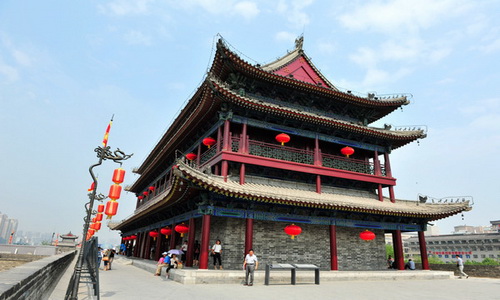
Meanwhile, the tower was also functioned to sound the night watches and give alarms. The 30-meter-high archery tower is the third defensive line. It is the highest point of the entire defensive system, with dozens of windows in the outer walls for the guards to look down and shoot arrows from all directions. The barbican entrance (called Wengcheng in Chinese) is the most unique part of the City Wall, which was actually a trap to corner the enemies when the outer wall was broken. The city gate is surely the last defensive line of the City Wall, which was unbreakable no matter for being attacked by striking or fire.
- Cycling
- Walk
- Battery Cart
Biking is the most popular and ideal way to tour around the ancient City Wall, which takes about one hour for a whole circle in an anti-clockwise direction.
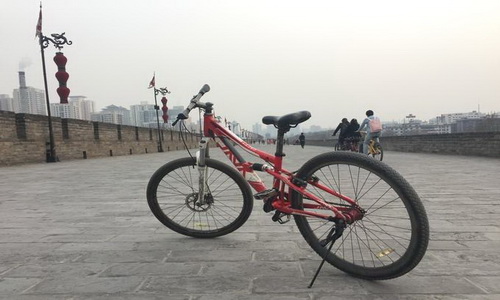
For leisure and senior travelers, taking a relaxing walking is rather recommended. You could sight-see the city wall on your own pace to discover every antique brick or tower. You do not have to cover the whole City Wall for a round way, but hike a short part of it and get down the wall from any nearest gate.
There are also battery carts to drive visitors all the way around the City Wall. It is energy-saving and enable you to enjoy a panoramic view of the city, including the old residence inside the old downtown city center and modern skyscrapers outside the wall. The battery cart charges CNY120 for a round tour (covering all four sections), and CNY30 for each section.
1. In travel peak season and holidays, there will be routine performances on the City Wall, including the gate opening ceremony and walking sculptures show in the morning. You are also given a chance to see live soldiers to array in their battle formation and relieve guard by wearing majestic-looking armor from Qin Dynasty. Most performances take place in the South Gate Square and inside the Wengcheng.
2. Many cultural activities would be held on the City Wall annually, such as the brilliant Lantern Fair held every lunar New Year, and the spectacular wedding ceremony in which hundreds of couples are dressed in Han Chinese Clothing.
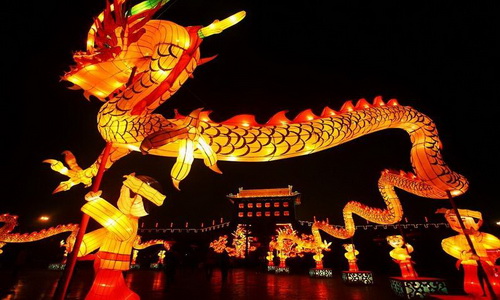
3. Every year, the City Wall would be highlighted by an International Marathon. It has witnessed the race 23 times since 1993. Runners at home and abroad get a chance to participate in the game.
South Gate (08:00-22:00)
Hanguang Gate (08:00-17:30)
East Gate, West Gate and North Gate (April 1-30, 08:00-18:00; May 1-Oct 31, 08:00-19:00; Nov 1-Mar 31, 08:00-18:00)
Admission Fee:CNY 54 per adult Tourist facilities on the wall:Shops, souvenir stores, benches, bicycles, rickshaw service and electric car. Wheel Chair is accessible. Normally, tourists would walk or cycle on the wall. Time needed:1-2 hours. Normally, it takes about 1.5 hours by bike to cover a circle. Best season:All year round. In July or August, it is suggested to tour the wall in the morning or after sunset because it is quite hot at noon and you could hardly find a shade on the wall. In winter, it might be chilly and windy on the wall, but the snow-covered scenery would be stunning.- The Bell Tower, Drum Tower and the Muslim Quarter are inside the City Wall, and it takes about a dozen minutes to walk to those spots from the wall.
- At night, the City Wall, Bell Tower and Drum Tower are outlined brilliantly with lights to create greatly fascinating spots that you won't want to miss.
- The park around the City Wall abounds with plants, pavilions and sculptures. Every morning and evening, the locals would gather here practicing Tai Chi, dancing, walking, etc. Visitors could also cruise the moat by a small boat.









